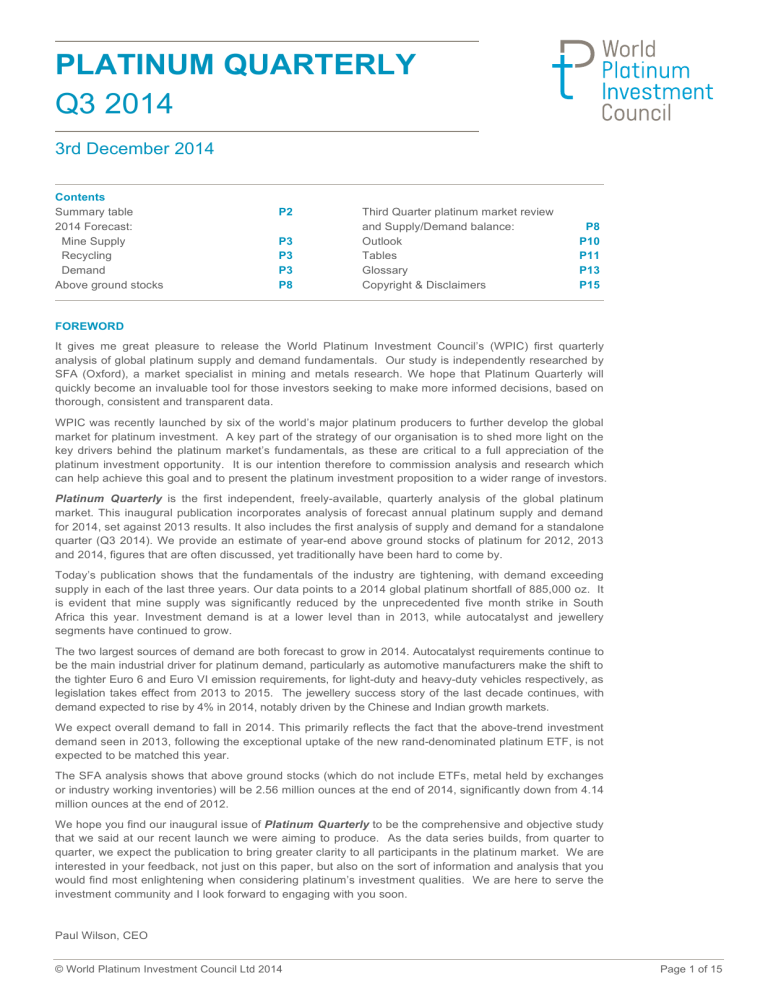Download Platinum Quarterly - World Platinum Investment Council

PLATINUM QUARTERLY
Q3 2014
3rd December 2014
Contents
Summary table
2014 Forecast:
Mine Supply
Recycling
Demand
Above ground stocks
P2
P3
P3
P3
P8
Third Quarter platinum market review and Supply/Demand balance:
Outlook
Tables
Glossary
Copyright & Disclaimers
P8
P10
P11
P13
P15
FOREWORD
It gives me great pleasure to release the World Platinum Investment Council’s (WPIC) first quarterly analysis of global platinum supply and demand fundamentals. Our study is independently researched by
SFA (Oxford), a market specialist in mining and metals research. We hope that Platinum Quarterly will quickly become an invaluable tool for those investors seeking to make more informed decisions, based on thorough, consistent and transparent data.
WPIC was recently launched by six of the world’s major platinum producers to further develop the global market for platinum investment. A key part of the strategy of our organisation is to shed more light on the key drivers behind the platinum market’s fundamentals, as these are critical to a full appreciation of the platinum investment opportunity. It is our intention therefore to commission analysis and research which can help achieve this goal and to present the platinum investment proposition to a wider range of investors.
Platinum Quarterly is the first independent, freely-available, quarterly analysis of the global platinum market. This inaugural publication incorporates analysis of forecast annual platinum supply and demand for 2014, set against 2013 results. It also includes the first analysis of supply and demand for a standalone quarter (Q3 2014). We provide an estimate of year-end above ground stocks of platinum for 2012, 2013 and 2014, figures that are often discussed, yet traditionally have been hard to come by.
Today’s publication shows that the fundamentals of the industry are tightening, with demand exceeding supply in each of the last three years. Our data points to a 2014 global platinum shortfall of 885,000 oz. It is evident that mine supply was significantly reduced by the unprecedented five month strike in South
Africa this year. Investment demand is at a lower level than in 2013, while autocatalyst and jewellery segments have continued to grow.
The two largest sources of demand are both forecast to grow in 2014. Autocatalyst requirements continue to be the main industrial driver for platinum demand, particularly as automotive manufacturers make the shift to the tighter Euro 6 and Euro VI emission requirements, for light-duty and heavy-duty vehicles respectively, as legislation takes effect from 2013 to 2015. The jewellery success story of the last decade continues, with demand expected to rise by 4% in 2014, notably driven by the Chinese and Indian growth markets.
We expect overall demand to fall in 2014. This primarily reflects the fact that the above-trend investment demand seen in 2013, following the exceptional uptake of the new rand-denominated platinum ETF, is not expected to be matched this year.
The SFA analysis shows that above ground stocks (which do not include ETFs, metal held by exchanges or industry working inventories) will be 2.56 million ounces at the end of 2014, significantly down from 4.14 million ounces at the end of 2012.
We hope you find our inaugural issue of Platinum Quarterly to be the comprehensive and objective study that we said at our recent launch we were aiming to produce. As the data series builds, from quarter to quarter, we expect the publication to bring greater clarity to all participants in the platinum market. We are interested in your feedback, not just on this paper, but also on the sort of information and analysis that you would find most enlightening when considering platinum’s investment qualities. We are here to serve the investment community and I look forward to engaging with you soon.
Paul Wilson, CEO
© World Platinum Investment Council Ltd 2014 Page 1 of 15
PLATINUM QUARTERLY Q3 2014
Supply, demand and above ground stocks summary (Table 1)
Platinum Supply-demand Balance, (koz)
SUPPLY
Refined Production
South Africa
Zimbabwe
North America
Russia
Other
Increase (-)/Decrease (+) in Producer Inventory
Total Mining Supply
Recycling
Autocatalyst
Jewellery
Industrial
Total Supply
DEMAND
Automotive
Autocatalyst
Non-road
Jewellery
Industrial
Chemical
Petroleum
Electrical
Glass
Medical & Biomedical
Other
Investment
Change in Bars, Coins
Change in ETFs Holdings
Change in Stocks Held by Exchanges
Total Demand
Balance
Above Ground Stocks 4,140*
Source: SFA (Oxford)
*as of 31st December 2012
3,000
140
2,945
1,525
595
175
185
175
235
160
925
-10
900
35
8,535
1,120
855
10
7,840
3,140
-695
3,445
2013
6,070
4,355
405
355
740
215
-215
5,855
1,985
3,125
160
3,060
1,500
645
155
195
100
245
160
1,245
770
10
7,125
3,285
165
10
270
-115
8,010
-885
2,560
2014f Growth %
4,730 -22%
2,985
400
390
740
215
+370
5,100
2,025
-31%
-1%
10%
0%
0%
-13%
2%
4%
14%
4%
-2%
8%
-11%
5%
-43%
4%
0%
-82%
200%
-70%
-429%
-6%
11%
-10%
0%
-9%
5%
27%
-26%
Q3 2014
1,850
770
730
40
745
-200
0
-95
-105
1,695
155
380
165
35
50
25
65
40
1,275
820
100
105
200
50
+15
1,290
560
365
195
0
Prepared by SFA (Oxford) for World Platinum Investment Council Page 2 of 15
PLATINUM QUARTERLY Q3 2014
2014 FORECAST
Mine supply
On 23 January, some 70,000 Association of Mineworkers and Construction Union (AMCU) members embarked on a co-ordinated strike at Anglo American Platinum, Lonmin and Impala Platinum flagship mines in South Africa. A deal was signed with unions on 24 June, effectively ending the longest mine strike in South Africa’s history. As a result, refined platinum production for South Africa is forecast to be down by a total of 1.37 million ounces (moz) for the year versus production volumes for 2013. This shortfall also includes the full-year impact of closures of some marginal mines in 2013. Refined output from South Africa is therefore forecast to be down 31% to 2.99 moz compared to 2013.
Outside South Africa, refined metal production remains largely flat year-on-year. Output from Zimbabwe is set to fall 5 koz owing to mining and expansion delays. Refined output from North America is forecast to rise by 10% to 290 koz as supply from Canada increases. Meanwhile, refined production from Russia and the balance of world supply are expected to remain around 740 koz and 215 koz respectively.
Despite disruptions to mine supply, South African producers were able to sell additional ounces from stocks and from releases from their metallurgical pipelines. SFA (Oxford) estimates that stock holdings increased by 215 koz in 2013 as production exceeded sales. In 2014, however, an estimated 370 koz of stock sales brings supply from mining companies to 5.1 moz (Chart 1), a reduction of 755 koz or 12.9% down on 2013. koz
6,000
Total mining supply summary, 2014f (chart 1)
370
5,000
740
215
4,000
400
390
2,985
3,000
5,100
4,730
2,000
1,000
0
South Africa Zimbabwe North America Russia Other Refined
Production
Change in producer inventory
Total Mining
Supply
Source: SFA (Oxford)
Recycling
Total recycling is forecast to increase by 2% to 2.03 moz as growth in supply from spent autocatalysts is partially offset by lower jewellery scrap volumes. Global supply from autocatalyst recycling is likely to grow by an estimated 11% to 1.25 moz. The majority of the growth is expected in Europe, which rises by a quarter or 90 koz to 455 koz. The number of catalysts scrapped is projected to increase by 6%, but platinum recycling growth is higher as more diesel catalysts are being collected relative to gasoline following the diesel vehicle sales boom in Europe that started in the late 1990s. Diesel catalysts have a higher proportion of platinum relative to palladium, as well as higher loadings relative to gasoline catalysts.
Recycling was up in the third quarter, but it is evident that collection rates are decreasing through the fourth quarter as lower prices delay collection from scrapyards and this may shift some collection to early next year.
Demand
SFA (Oxford) forecasts gross global demand for platinum to fall by 6.2% to 8.01 moz in 2014 (Chart 2).
Investment is the main contributor to the contraction (Chart 3), with an estimated 760 koz reduction in demand year-on-year. South African ETF holdings are expected to grow by 310 koz, which is 595 koz less growth than in 2013, and metal held by exchanges is predicted to reduce by 114 koz, reflecting net long futures contracts’ liquidation, which dropped by 32% during Q3 2014. Industrial demand is forecast to drop
1.6% to 1.50 moz, owing mainly to reductions in plant capacity in the glass and oil industries. Nevertheless, platinum’s most substantial end-users – the automotive and jewellery sectors – are likely to see growth of
Prepared by SFA (Oxford) for World Platinum Investment Council Page 3 of 15
PLATINUM QUARTERLY Q3 2014
4.6% and 3.9% respectively this year. Higher loadings associated with Euro 6 tailpipe emissions legislation are leading to increased requirements for platinum in Europe, while jewellery demand continues to grow in
India. Meanwhile, Chinese platinum jewellery requirements are forecast to rise, bucking the headline trend of lower imports and reduced buying on the Shanghai Gold Exchange (SGE) which is a consequence of a fall in demand from industrial requirements after exceptional buying in 2013.
Changes in demand by category, 2014f vs 2013 (chart 2) koz
9,000
+145
+115
+50
+10
+10
-20 -75
8,000
-760
7,000
8,535
8,010
6,000
5,000
2013 Automotive Jewellery Chemical Petroleum Electrical Glass Medical and
Biomedical
Investment 2014f
Source: SFA (Oxford)
Autocatalyst demand
Global on-road autocatalyst demand for platinum is forecast to rise by 4.2% to 3.13 moz in 2014, compared to the previous year. This is above the projected growth in automotive production of 3.3%.
Within this, the passenger car segment is set to grow 4.0% year-on-year, more than offsetting the 2% drop in heavy commercial vehicle production.
The majority of the growth in autocatalyst platinum consumption is from Western Europe, which is projected to be up 5.9% to 1.34 moz as Euro 6 emissions legislation takes effect, requiring more platinum per vehicle than in 2013. Vehicle output from Western Europe is growing by 3.6%, while diesel’s share of the passenger car market is forecast to drop slightly to 53%. Also, engine sizes are continuing a downsizing trend, and heavy commercial vehicle production is estimated to fall 9.3% owing to a spike in buying of Euro 5-compliant vehicles ahead of Euro 6 coming into force.
Thus the resulting 75 koz of growth in platinum demand in Western Europe is from higher metal loadings associated with tighter tailpipe emissions standards through the promulgation of Euro 6 legislation. Euro 6 for diesel and gasoline light vehicles came into force for new vehicle approvals on 1 September 2014, and will apply to all new registrations from 2015. The main change is to cut the diesel NO x
limit by more than half to 80 mg/km, compared to just a 20% reduction for Euro 5. Selective catalytic reduction (SCR) technology, which does not use platinum or other platinum-group metals, is being deployed on larger diesel cars to comply with Euro 6. Other NO x
-reducing technologies, such as lean NO x
traps (LNT), which contain platinum as the oxidation catalyst and rhodium as the reduction catalyst, are being deployed by manufacturers for smaller vehicles.
Euro VI standards became mandatory for heavy-duty vehicle registrations from 1 January 2013 for new type approvals and for all new vehicles from 1 January 2014. Heavy-duty vehicles are required to reduce
NO x
by 80% and particulate matter by over 90% compared to Euro V levels (2009) and this has boosted requirements for platinum in diesel particulate filters (DPFs). However, at present, increased loadings have been offset by falling vehicle production.
North American demand is forecast to rise as a result of combined growth from the production of heavyduty vehicles and diesel light trucks and the increased uptake of diesel passenger cars, albeit from a low base. Automotive sales look set to reach the highest levels since 2007 on the back of lower fuel prices and attractive financing options. Platinum consumption in North America is therefore estimated to rise 8.2% year-on-year in 2014 to 395 koz.
Prepared by SFA (Oxford) for World Platinum Investment Council Page 4 of 15
PLATINUM QUARTERLY Q3 2014
In Japan vehicle sales registrations are up 4.5% in the year to September but fell by over 9% in October, which was the third consecutive monthly reduction. Nevertheless, vehicle manufacture remains robust as car makers in Japan are generating good returns on exports in 2014 due to the 12% decline in the value of the yen against the US dollar since the beginning of the year. A reduction in platinum loadings in gasoline catalysts has been partially offset by slight increases in diesel car and heavy commercial vehicle production. This, along with minor growth in overall vehicle output, is expected to keep platinum demand flat at 570 koz.
Thirteen major cities in India currently have Bharat Stage (BS) IV standards, similar to Euro IV heavy-duty and Euro 4 light-duty standards, with the rest of the country at BS III. As more than half of passenger cars in India are diesel-powered and production is almost three-times higher than before the financial crisis, many cars now have diesel oxidation catalysts. A slight drop in diesel share does not quite offset the slight increase in vehicle production, lifting platinum demand forecasts by 3.1% to 165 koz for the year.
Consumption growth from China is expected to drop 3.8% to 125 koz, while that from the Rest of the
World (RoW) remains relatively steady, rising by 20 koz year-on-year to 530 koz. A drop in demand in
Thailand, Brazil and Argentina is offset by greater requirements from South Korea and other parts of South
East Asia.
Non-road engine catalyst demand
This is an important year for platinum use in non-road engines. In the US, Tier 4 emissions legislation became fully effective for smaller engines in September 2014, and requires a significant reduction in both
NO x
and particulate matter levels for non-road diesel engines. At the Tier 4 stage, the EPA also mandated a reduction in sulphur content in non-road diesel fuels. In Europe, Stage 4 regulations came into force for non-road diesel engines in 2014, with limits being imposed on more powerful vehicles from January, before being enforced for less powerful vehicles from October. Many engines at Stage 4 require the addition of a catalysed DPF (CDPF) which traps particulate matter.
Jewellery demand
Despite the drop in SGE trading and imports into China, jewellery demand has held up in 2014. In 2013, jewellery retailers bought gold as the gold price collapsed, leading to a ‘gold rush’, so retailer stocks of platinum were low until the end of the year when significant restocking started in December. Retailers predicted gold jewellery sales would underperform in 2014, so they shifted their focus to platinum jewellery.
In the first quarter of 2014 many jewellery retailers in China achieved double-digit sales growth, and this was reflected in strong buying on the SGE.
The second quarter is normally a weak period for the jewellery market. Manufacturers and retailers were well-stocked and trading and imports dropped. Many retailers launched new products in the third quarter, which coincided with Golden Week and the wedding season, so jewellery sales are estimated to be up in the mainland Chinese market. China’s major jewellery retailers continued to expand their jewellery sales points in China throughout 2014. The country has also reportedly surpassed the US to become the largest online shopping market. However, political disturbances in Hong Kong affected mainland tourist buying and sales there will continue to be affected as long as the protests last.
Jewellery demand in Japan has held up relatively well and is estimated to remain flat at 335 koz in 2014.
This takes account of the tax hike from 5% to 8% and its impact on sales from April, as well as higher local platinum prices which peaked at just under ¥5,000/g in July. This brought forward consumer buying to the first quarter of the year and led to a reduction in purchases in the second quarter and a year-on-year fall in the third. So far, overall demand is up slightly, but the final quarter could decide whether requirements slip into negative territory. A number of new platinum campaigns were launched throughout 2014, with a new one in September. Meanwhile, platinum prices that are back to the mid-¥4,000/g level would normally support demand. However, consumer confidence is likely to be dented by political uncertainty ahead of a snap election called by the Prime Minister for December, against a backdrop of the country slipping back into recession.
Platinum jewellery continues to gain ground in India, with 25% growth in demand to 175 koz forecast for
2014. Compared to the universal appeal of gold, the platinum jewellery market in India is niche, with platinum pitched as a premium jewellery metal over gold to a mainly young, urban clientele. India is the least price sensitive of the platinum jewellery markets; buyers see it as a store of value and expect it to appreciate in value. A premium over gold helps to maintain platinum’s attraction.
Prepared by SFA (Oxford) for World Platinum Investment Council Page 5 of 15
PLATINUM QUARTERLY Q3 2014
Sales have tended to be especially strong around the main festival seasons, such as Eid and Diwali.
Platinum Guild International (PGI), with its trade and retail partners, has recently launched its EVARA
Platinum Blessings campaign, marking the entry of platinum into the bridal jewellery segment in India. A growing bridal market might be expected going forward.
In summary, purchasing by jewellery manufacturers held up throughout 2014 and was particularly strong in the third quarter. Gross global demand is therefore estimated to rise by 3.9% for the year to 3.06 moz.
Industrial demand
Industrial demand is estimated to be down 1.6% relative to 2013 at 1,500 koz this year. Owing to plant overcapacity, consumption is forecast to fall by 75 koz and 20 koz in the glass and petroleum sectors respectively. These contractions are partially offset by growth in chemical demand and other end-uses.
Industrial demand went through a period of significant capacity expansion and maintenance in China during 2013, and while usage has grown this year, reduced consumption and more recycling has curbed the need for new metal imports. Cumulative sales on the SGE reached close to 900 koz by the end of
October compared to 1.16 moz over the same period in 2013. During May, trading dropped to a low of 50 koz compared to normal average sales of 90 koz. In the year to September, platinum exports to China and
Hong Kong are estimated to have declined by over 350 koz and are back to 2012 levels.
Chemical
Chemical demand for platinum was relatively strong in 2013 at 595 koz and is forecast to increase by 8.4% to 645 koz in 2014 owing to greater capacity in chemical processes. Paraxylene capacity has grown in
2014. China demands more paraxylene than it produces currently and this shortfall is being met by other paraxylene producers in Asia and the Middle East, as construction to add new paraxylene plants has run into issues in China due to environmental concerns from the general public.
Construction of new propane dehydrogenation (PDH) plants, particularly in China, also led to a rise in platinum demand. These PDH plants have been built because of the current excess supply of propane and the undersupply of propylene, both caused by the increasing supply of shale gas.
Petroleum
There has been a shift in refining capacity from OECD countries to non-OECD countries caused by a decline in demand in developed countries and a major rise in demand in developing countries. An increase in capacity in non-OECD countries has led to higher exports of petroleum products to other parts of the world, as supply in these regions has outstripped demand. However, this additional supply has led to falling refining margins at older refineries, mainly those in OECD countries. This culminated in a number of closures and cuts in reforming capacity in Europe and Japan, leading to a 20 koz drop in consumption in
2014 to 155 koz.
US refiners have generally been immune to closures seen elsewhere owing to the expansion in supply from shale oil leading to a lower feedstock price for refiners and improved margins. This has led to platinum usage in the US remaining constant in 2013 and 2014 at 35 koz.
Demand for platinum was down 30 koz in Western Europe in 2013 and is forecast to fall another 35 koz in
2014, with platinum being sold back to the market. Cuts to capacity have been driven by competition from other regions with lower costs, weaker European demand for petrochemical products, as excess gasoline used to be exported to the east coast of the US and Africa, both of which are now able to access cheaper supplies from elsewhere.
Chinese refineries expanded capacity, particularly in 2013, leading to growth in platinum consumption.
Platinum demand in 2013 (65 koz) was considerably higher than is expected in 2014 (25 koz) owing to the rapid expansion of ‘teapot’ (independent) refineries to meet an end-of-2013 deadline set by the government to eliminate smaller plants. Alongside this, in 2013 and continuing into 2014, larger refineries expanded as policymakers aimed to not only meet the expected increase in demand for domestic refined products, but also to become larger exporters of refinery products.
The RoW is forecast to experience 11% growth in demand for platinum in 2014 to 150 koz, as refinery capacity expands and new gas-to-liquids (GTL) plants are built.
Prepared by SFA (Oxford) for World Platinum Investment Council Page 6 of 15
PLATINUM QUARTERLY Q3 2014
Source: SFA (Oxford)
Electrical
Platinum demand for electrical applications is forecast to increase by 5% from the previous year to 195 koz.
Higher demand in the RoW accounts for the majority of the rise, as consumption in other areas is expected to remain relatively flat. Demand for hard disk drives (HDDs) has stabilised, with slight growth now expected in 2014. The enterprise (cloud storage), external (branded) and consumer electronics sectors are the main drivers of growth in HDD shipments, offsetting the projected decline in personal computer demand.
Glass
Demand for platinum from the glass sector is projected to be down 75 koz in 2014, mainly due to overcapacity in China and the developed world. China saw strong growth in 2013, mainly from LCD glass capacity expansions which have not been repeated in 2014. There have been plant closures in Western
Europe, Japan and the US over this period, keeping platinum demand from these regions relatively low or in negative territory.
Most expansions and new plant construction are occurring in Eastern Europe, South America and South
East Asia where glass companies feel there will be increasing demand for their products as these countries develop. These expansions are mostly focused on float glass production for use in construction and autos, as there is an oversupply of LCD glass currently, which use significantly higher quantities of platinum. The capacity of glass production for photovoltaics has fallen over the last few years owing to oversupply, and some of these plants are being converted to float glass production.
Prepared by SFA (Oxford) for World Platinum Investment Council Page 7 of 15
PLATINUM QUARTERLY Q3 2014
Investment demand
ETF demand was relatively quiet at the beginning of 2013 with investors in the US making steady purchases, while European investors sold a small amount of their holdings. However, the launch of Absa’s
NewPlat ETF in April was enthusiastically embraced by South African investors and it had gained over 900 koz by the end of the year. This made the NewPlat ETF the fastest growing ETF and in six months the largest single global platinum ETF. This ETF was attractive to fund managers in South Africa because it provided exposure to platinum using on-shore investment allowances. In addition it provided a currency hedge.
During 2014 we estimate global platinum ETF holdings will increase by 270 koz. A second ETF was launched in South Africa by Standard Bank in March and investors in South African ETFs continued to add to their holdings, albeit not on the same scale as that seen in 2013. Even with reduced inflows this year compared to 2013, the South African ETFs were still the main driver of global ETF demand.
Net coin and bar sales have made little contribution to platinum demand because the level of recycling is expected to closely match new purchases. In response to strong expressions of interest from investors and collectors the US Mint reintroduced the one ounce American Eagle Platinum Bullion Coin in 2014 with modest sales reaching 17 koz to date.
Above ground stocks
The aftermath of the global financial crisis has been a build-up of metal holdings as a result of mining and recycling supply exceeding demand for several years. This build-up has been acknowledged by industry participants but its quantification avoided as it typically represents vaulted metal holdings held confidentially. In this report we define above ground stocks as the year-end estimate of the cumulative platinum holdings not associated with: exchange traded funds, metal held by exchanges or working inventories of mining producers, refiners, fabricators or end-users. Typically, unpublished vaulted metal holdings from which a supply/demand shortfall can be readily supplied or to which a supply/demand surplus can readily flow. It is this stock that has been able to provide metal to satisfy the shortfall between demand and supply.
We estimate that above ground stocks, which exclude ETFs, metal held by exchanges and industry working inventories will be 2.56 million ounces at the end of 2014.
The last two annual platinum shortfalls have reduced above ground stocks from their level of 4.14 million ounces at the end of 2012.
THIRD QUARTER PLATINUM MARKET REVIEW
Several references to Q3 performance have been included in the commentary above. This short section focuses on the market balance for the third quarter, and its principal influences.
In contrast to the year in review, supply exceeded demand in the third quarter of 2014 by 155 koz.
The third quarter tends to be the seasonally weakest quarter for automotive production, with an estimated
730 koz required in this quarter to match vehicles produced. This, combined with net sales by investors, a post-strike ramp-up in refined output in South Africa and increased recycling, has resulted in the platinum surplus softening the market. A key component of the surplus is the net outflow of 200 koz from investment.
European funds saw a net reduction of 5% while South African funds experienced a 2% reduction leading to a 95 koz decline in platinum held in ETFs. Meanwhile, platinum stocks held by NYMEX fell by 107 koz over the quarter as investors liquidated speculative derivative positions representing over 1 million ounces in the futures market.
Prepared by SFA (Oxford) for World Platinum Investment Council Page 8 of 15
PLATINUM QUARTERLY Q3 2014
Supply-demand balance, koz (chart 4)
+155
Source: SFA (Oxford)
-695
2013
-885
2014f Q3, 2014
Prepared by SFA (Oxford) for World Platinum Investment Council Page 9 of 15
PLATINUM QUARTERLY Q3 2014
OUTLOOK
Refined production is likely to be higher in 2015 as South African mines fully recover from the 2014 strike, although it is unlikely that supply will return to 2013 levels. Producer metal sales are expected to be more in line with production, although some excess stock sales may still occur in the first quarter of 2015, and there will be an increase in metal lock-up in the metallurgical pipeline.
Delayed collection in the fourth quarter of 2014 is likely to boost recycling volumes in early 2015, and an anticipated further increase in platinum from scrapped diesel catalysts from Europe would lift overall recycling volumes for the year.
Autocatalyst requirements are forecast to be the main industrial driver for platinum demand in 2015, as platinum benefits from a higher proportion of Euro 6-compliant vehicles being manufactured and the production of heavy-duty vehicles in Europe returns to growth. Euro 6 legislation came into force in
September 2014 for new models and will be enforced for all light vehicles sold from September 2015. The imposition of Euro 6 legislation supports higher platinum demand, despite diesel’s share of light vehicle powertrains dropping slightly and vehicle production growing only modestly. Some thrifting can be expected thereafter, once the new formulations have been proved.
Heavy-duty on-road vehicle sales rose ahead of the introduction of Euro VI legislation in 2014, as fleet operators sought to avoid the cost penalty by buying cheaper Euro V vehicles. Consequently, sales of new
Euro VI-compliant heavy-duty vehicles have so far been slow through 2014, but should begin to accelerate in 2015, with a corresponding increase in platinum loadings and therefore demand, as fleet operators replace their old vehicles.
India, the second-largest diesel light vehicle market after Western Europe, is in flux after the government reduced the long-term subsidy on diesel fuel, so drivers are increasingly forced to pay the real additional cost of diesel fuel over gasoline. With a high diesel share, rapid growth in vehicle ownership and the prospect of tighter emissions legislation, India represents an important growth market for platinum in autocatalysts. The rising fuel price will inevitably curb demand growth, but the government remains committed to diesel vehicles as a way to reduce vehicle CO
2
emissions.
Demand for jewellery is forecast to remain robust in China, while growth is forecast in India as platinum continues to establish itself through sustained marketing by retailers and the PGI. Overall industrial demand is projected to be slightly higher in 2015. There are new PDH plants being built in China and the
US which, along with a small increase in other chemical usage, should help to lift requirements for platinum. As in 2014, there will continue to be petroleum refinery capacity expansions in developing countries leading to higher platinum demand in those regions.
Against this growth, a reduction in capacity is expected to continue in Europe and Japan owing to decreasing oil product demand and poor margins, while platinum consumption in the US is likely to remain steady. Demand for platinum for glass in China will be similar to that seen in 2014, while in the developed world it will remain sluggish. Meanwhile, the rate of glass plant expansion in South America and Eastern
Europe is predicted to slow, and in South East Asia there are expected to be some plant expansions.
Prepared by SFA (Oxford) for World Platinum Investment Council Page 10 of 15
PLATINUM QUARTERLY Q3 2014
Supply, demand and above ground stocks summary (Table 1)
Platinum Supply-demand Balance, (koz)
SUPPLY
Refined Production
South Africa
Zimbabwe
North America
Russia
Other
Increase (-)/Decrease (+) in Producer Inventory
Total Mining Supply
Recycling
Autocatalyst
Jewellery
Industrial
Total Supply
DEMAND
Automotive
Autocatalyst
Non-road
Jewellery
Industrial
Chemical
Petroleum
Electrical
Glass
Medical & Biomedical
Other
Investment
Change in Bars, Coins
Change in ETFs Holdings
Change in Stocks Held by Exchanges
Total Demand
Balance
Above Ground Stocks 4,140*
Source: SFA (Oxford), *as of December 2012
2013
6,070
1,985
1,120
855
10
7,840
3,140
3,000
140
2,945
1,525
4,355
405
355
740
215
-215
5,855
-10
900
35
8,535
595
175
185
175
235
160
925
-695
3,445
2014f Growth %
4,730 -22%
2,025
1,245
770
10
7,125
3,285
3,125
160
3,060
1,500
2,985
400
390
740
215
+370
5,100
645
155
195
100
245
160
165
10
270
-115
8,010
-885
2,560
27%
-26%
2%
11%
-10%
0%
-9%
5%
4%
14%
4%
-2%
-31%
-1%
10%
0%
0%
-13%
8%
-11%
5%
-43%
4%
0%
-82%
200%
-70%
-429%
-6%
Q3 2014
560
365
195
0
1,850
770
730
40
745
1,695
155
380
165
35
50
25
65
40
1,275
820
100
105
200
50
+15
1,290
-200
0
-95
-105
Prepared by SFA (Oxford) for World Platinum Investment Council Page 11 of 15
PLATINUM QUARTERLY Q3 2014
Regional demand (Table 2)
Platinum Gross Demand (koz)
Automotive
Jewellery
Chemical
Petroleum
Electrical
Glass
Medical and Biomedical
Other industrial
Investment
North America
Western Europe
Japan
China
India
Rest of the World
North America
Western Europe
Japan
China
India
Rest of the World
North America
Western Europe
Japan
China
Rest of the World
North America
Western Europe
Japan
China
Rest of the World
North America
Western Europe
Japan
China
Rest of the World
North America
Western Europe
Japan
China
Rest of the World
North America
Western Europe
Japan
China
Rest of the World
2013
10
0
90
60
235
20
20
15
80
50
175
15
-30
-30
65
135
185
65
70
30
170
260
175
35
90
90
20
15
20
160
925
2,945
200
220
335
1,990
140
60
595
3,140
420
1,340
580
130
160
510
8,535
2014f
Total Demand
Prepared by SFA (Oxford) for World Platinum Investment Council
8,010
5
-10
30
75
245
20
20
15
80
60
100
0
-35
-20
25
150
195
70
70
30
205
270
155
35
95
95
20
15
20
160
165
3,060
230
225
335
2,030
175
65
645
3,285
455
1,420
590
125
165
530
Growth %
5%
-50% n/a
-67%
25%
4%
6%
6%
0%
0%
0%
0%
17%
-33%
-62%
11%
5%
0%
0%
0%
0%
20%
-43%
-100%
0%
2%
25%
8%
8%
8%
0%
0%
21%
4%
-11%
0%
8%
6%
2%
-4%
3%
4%
4%
15%
2%
-82%
-6%
Q3 2014
770
745
165
35
50
25
65
40
-200
1,695
Page 12 of 15
PLATINUM QUARTERLY Q3 2014
GLOSSARY
Above ground stocks
The year-end estimate of the cumulative platinum holdings not associated with: exchange traded funds, metal held by exchanges or working inventories of: mining producers, refiners, fabricators or end-users. Typically, unpublished vaulted metal holdings from which a supply/demand shortfall can be readily supplied or to which a supply/demand surplus can readily flow.
Bharat Stage III/IV standards
Bharat Stage III is equivalent to Euro 3 emissions legislation. Introduced in 2005 in 12 major cities across India and enforced nationwide from April
2010. Bharat Stage IV is equivalent to Euro 4 emissions legislation. Introduced in 2010 in 14 major cities across India and set to be enforced nationwide from April 2017.
Diesel particulate filter (DPF) and catalysed diesel particulate filter (CDPF)
A DPF physically filters particulates (soot) from diesel exhaust. A CDPF adds a PGM catalyst coating to facilitate oxidation and removal of the soot. The terms are often used interchangeably.
Emissions legislation
Tailpipe regulations covering emissions of particulate matter, hydrocarbons and oxides of nitrogen.
ETF
Exchange-traded fund. A security that tracks an index, commodity or basket of assets. Platinum
ETFs included in demand are backed by physical metal.
Euro V/VI emission standards
EU emissions standards for heavy duty vehicles.
Euro V legislation introduced in 2009, Euro VI in
2013/2014, will be widely adopted later in other regions.
Euro 5/6 emission standards
EU emissions standards for light duty vehicles.
Euro 5 legislation introduced in 2009, Euro 6 in
2014/2015, will be widely adopted later in other regions.
GTL
Gas to liquids is a refinery process that converts natural gas to liquid hydrocarbons such as gasoline or diesel fuel.
HDD
Hard disk drive.
HDV
Heavy-duty vehicle. koz
Thousand ounces.
LCD
Liquid-crystal display used for video display.
LCV
Light commercial vehicle.
Lean NO x
traps (LNT)
Rhodium-based, catalyses the chemical reduction of NO x
in diesel engine exhaust to harmless nitrogen. moz
Million ounces.
Net demand
A measure of the theoretical requirement for new metal, i.e. net of recycling.
Non-road engines
Non-road engines are diesel engines, used in construction, agricultural and mining equipment for example, taking engine and emissions technology similar to on-road heavy-duty diesel.
OECD
Organisation for Economic Co-operation and
Development, consisting of 34 developed countries. oz
A unit of weight commonly used for precious metals. 1 troy ounce = 1.1 ounces.
Paraxylene
A chemical produced from petroleum naphtha extracted from crude oil using a platinum catalyst.
This is used to manufacture terephthalic acid which is used to manufacture polyester.
PDH
Propane dehydrogenation, where propane is converted to propylene.
PGMs
Platinum-group metals.
Refined production
Processed platinum output from refineries.
Secondary supply
Recycling output.
Prepared by SFA (Oxford) for World Platinum Investment Council Page 13 of 15
PLATINUM QUARTERLY Q3 2014
Selective catalytic reduction (SCR)
PGM-free, converts harmful NOx in diesel exhaust to harmless nitrogen, via a tank of urea solution.
Used in heavy-duty diesel vehicles, increasingly competes with LNT in light-duty diesel vehicles.
SGE
Shanghai Gold Exchange.
Stage 4 regulations
European emission standards implemented in 2014 for non-road diesel engines.
Three-way catalyst
Used in gasoline cars to remove hydrocarbons, carbon monoxide and NOx. Largely palladiumbased now, some rhodium.
Tier 4 stage
Emissions standards phased in between 2008 and
2015 in the US for non-road vehicles.
____________
Ounce conversion
1 million ounces = 31.1 tonnes.
Prepared by SFA (Oxford) for World Platinum Investment Council Page 14 of 15
PLATINUM QUARTERLY Q3 2014
COPYRIGHT AND DISCLAIMER
Copyright
This document is subject to the terms and conditions on the World Platinum Investment Council website www.platinuminvestment.com
© SFA Copyright reserved. All copyright and other intellectual property rights in the data and commentary contained in this report remain the property of SFA, and no person other than SFA shall be entitled to register any intellectual property rights in the information, or data herein. No part of this report may be reproduced or distributed in any manner without attribution to the authors.
Disclaimer
This disclaimer governs the use of this document and by reviewing this document, you accept this disclaimer in full.
SFA has made all reasonable efforts to ensure that the sources of the information provided in this document are reliable, and the data reproduced are accurate at the time of writing. The analysis and opinions set out in the document constitute SFA’s judgment as of the date of the document and are subject to change without notice. Therefore, SFA cannot warrant the accuracy and completeness of the data, and analysis, contained in this document. SFA cannot be held responsible for any inadvertent occasional error, or lack of accuracy or correctness. SFA accepts no liability for any direct, special, indirect, or consequential losses or damages, or any other losses or damages of whatsoever kind, resulting from whatever cause through the use of, or reliance on, any information contained in the report. The material contained herein has no regard to the specific investment objectives, financial situation or particular need of any specific recipient or organisation. It is not to be construed as a solicitation, or an offer to buy or sell any commodities, securities or related financial instruments. The recipient acknowledges that SFA is not authorised by the Financial Conduct Authority to give investment advice. The report is not to be construed as advice to the recipient or any other person as to the merits of entering into any particular investment. In taking any decision as to whether or not to make investments, the recipient and/or any other person must have regard to all sources of information available to him. This document is provided for general information purposes only and the use of and reliance of the content of the report is entirely at your own risk.
Prepared by SFA (Oxford) for World Platinum Investment Council Page 15 of 15








